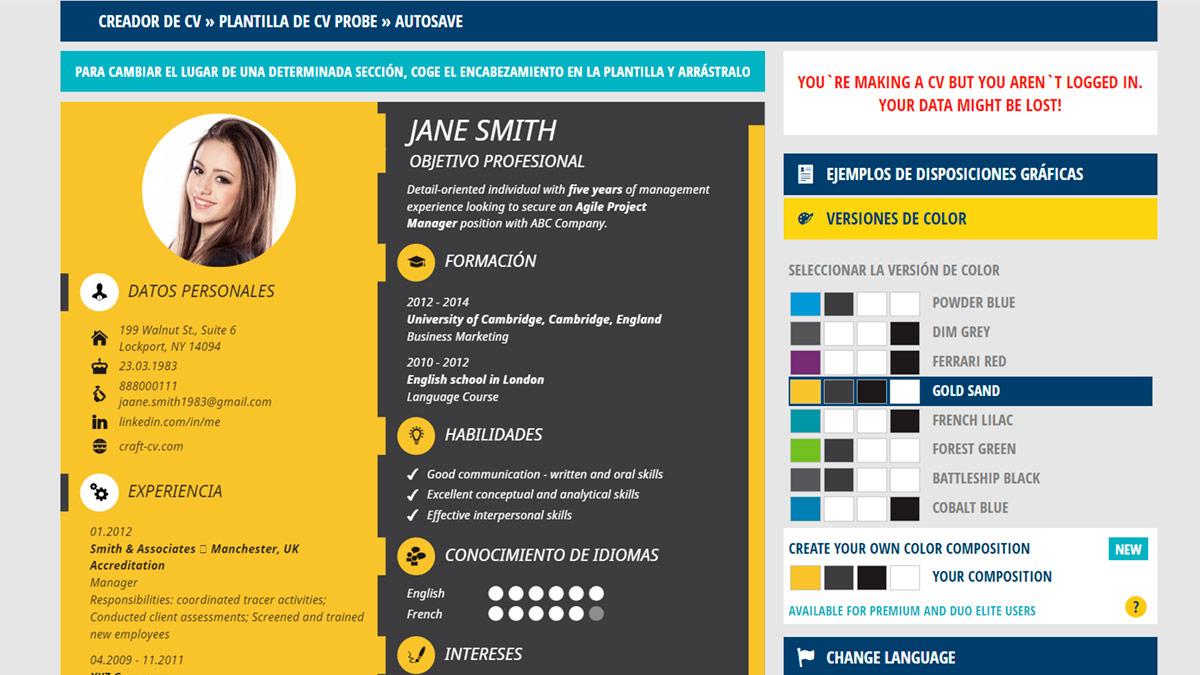
Source: Infosalus
Currently, there are many people who need a curriculum vitae that fits their options and personality. A good resume can not only make them notice you even more, but you can also achieve a picture perfect and attractive with all the purposes that you are going to fulfill.
In this post we are not only going to redirect you through the workplace and its job opportunities, but also, we are going to show you mainly, how to achieve all this just by creating an ideal curriculum vitae.
With a few simple steps you can achieve a successful profile.
The curriculum vitae

Source: Computer Hoy
A curriculum vitae or CV for its abbreviation is a document that is used as a tool to present an express and clear relationship of the data, skills and work experiences of a person, with the intention of being shortlisted for a job interview.
For you to understand it better, it is similar to a good advertisement or invitation sent or delivered by an applicant for a job, which includes all the information about their working life, contact information and indicates the place where they reside. The goal of a resume is to generate a good impression and interest to make yourself known and thus get a personal interview, ending with getting that job so desired.
Data
Personal data must be included in a curriculum vitae, in order to do more easy to read and understand who you are, how to contact you and what you have been doing in recent years.
Among the most important data are:
- Names and surnames.
- D.I.
- Date and place of birth.
- Civil status.
- Location of your domicile.
- Contact numbers, minimum two.
- Personal email address that you access frequently.
- Studies carried out indicating the start and end date, academic center, and place where they have been carried out.
- Postgraduate courses, courses or workshops also carried out indicating the start and end date, center, and place where they have been carried out.
- Professional experiences indicating the start and end date, company name and functions performed.
- Languages you master and at the corresponding level.
Possible mistakes
- That the title be it "Curriculum Vitae": if you want your CV to stand out from the rest, it is preferable to put another more striking title.
- Direction of email inappropriate: create a simple and professional email.
- All the spelling mistakes: It is one of the worst mistakes you can make. Make sure you write everything perfectly.
- Make a CV for all: Most people use the same resume for all job postings. You must customize your CV for each position.
- Very extensive: that your curriculum vitae has 4 pages does not mean that it is better. Add only the most important information.
- Use a the language difficult to read: avoid using many abbreviations, neologisms, technicalities, among others. You must also use neutral language.
- Include details that are not relevant: It is not bad to write your hobbies but if they do not contribute anything, it is better not to put them.
- Too creative: If you are a creative person, it is not bad to show it in your CV, but you should avoid overloading it by using different fonts, colors and others.
- Incoherence: Before submitting the resume, thoroughly review the dates verifying that it is correct with your work history. An inconsistent resume raises many suspicions, which can lead to you being discarded in the selection process.
- Not stand out your achievements: you should include your achievements, but without being too arrogant.
- Put wrong the data- Check that your numbers and email addresses are spelled correctly. Even if you are a good candidate for the position if you put your contact details wrong, you are lost.
- Very modest: If you have good things to show in your CV, put them without cutting yourself.
- Format boring: You should not be very creative, but not at all creative. Look for a format that attracts attention and has creative details that adapt to you, showing a part of your personality.
- Objective unclear: you must clarify what your objectives are, focusing them on the needs of the company.
- Different versions: use only one version of CV, and that this is the most attractive and the one that best suits your personality.
Types of resumes
Depending on the type of resume, it can be made up of different designs. Among them the following stand out:
- Chronological: it is the curriculum in which all the professional experience is organized by dates. always at the beginning the last place you were working. It favors you to use it if you have little or no experience and need a short CV.
- Reverse chronological: it is the most used, it is a variant of the previous CV. Although the order in which you must include professional experience changes, in this case you must start including from the most recent professional experience to the oldest. It is used when the positions held have been similar and constant over time.
- Functional chronological: the experience is classified according to the position and position held in each case. You must use it if you have held 2 or more positions but in different companies
- Mixed: it is the combination of the functional and chronological curriculum. It is the one that is most recommended and one of the most used, since it is more orderly and simple to look at.
- Creative: This type of resume has also been used a lot in the last year. Make a difference, especially if you apply in a sector such as design, publishing and these types of creative professions, thus giving a small preview of what you are capable of doing.
Steps to follow
It is important that you pay attention at this point in the post, since as we have mentioned before, a well-designed CV can help you find the job of your dreams. You just have to know what to say. Follow these steps where we show you how to make an attractive resume.
Describe a good profile of yourself
The professional profile consists of a short sentence highlighting your past work experience and your high compatibility with the vacancy found in the job offer. This should include your title or position, required skills, and proper aptitudes for the job.
Include contact information
Contact information is one of the most important sections of your CV. Most employers recommend including your full name, your phone number, and your email address. Make sure there are no errors in this section and that your contact information is up to date.
Add your own skills
In this step you need to do a analysis of your own personality to identify which skills make you more suitable for the position. For example, the simple fact of being in a position of contact with the client, maybe your creativity is not so relevant, while your sense of responsibility and order is. Try to be as objective as possible so that you can recognize your skills and competencies.
Strengthen your CV
Many companies use applicant tracking systems to scan a CV before it is read by a recruiter. These automated systems can search for specific words that you have included in your CV. If you want your information to pass this first filter, be sure to follow these steps:
- Send your CV in .DOC format instead of .PDF format.
- Put important information in the header or footer.
- Organize the text into bullets.
- Use keywords throughout the document.
What you should know. is that you can analyze the description of the position you are applying to and search LinkedIn for similar profiles so that you can extract keywords and use them in CV.
Project your previous works
Some vacancies lend themselves more than others to the presentation of examples. If you work, for example, in the design industry, attach to your CV A portfolio with some samples of your talent or include the link if you have a digital portfolio. On Behance you can create your account to upload examples of your work easily and for free.
Spelling and tone
Be aware that your resume does not have spelling mistakes. If you have doubts about a specific word, you can consult any spell checker available online. If you write your CV in English, check your spelling as well and try to take care of the tone with which you address others. It is very important that others see a correct image of your speech.
The photo
And last but not least, it is necessary that you have a profile photo that is in color, without scratches or pixels in between and that others can identify who you are. For this, it is preferable that you use a uniform background, or a monochrome background where nothing else stands out, except you.
Conclusion
If you have reached this point in the post, we invite you to start writing your resume based on the tricks that we have offered you.
Now we can only wish you the best of luck on your way to success!
Very good article, although we must consider that providing personal data such as the DNI, together with the full name and full address can bring us, for example, a problem of identity theft if that CV gets into the wrong hands or is distributed indiscriminately.
It is advisable not to provide the DNI or the complete address. If we get to the interview, they will already be asked of us or we will be able to facilitate them